
eBook - ePub
Digital Electronics
John Morris
This is a test
Share book
- 136 pages
- English
- ePUB (mobile friendly)
- Available on iOS & Android
eBook - ePub
Digital Electronics
John Morris
Book details
Book preview
Table of contents
Citations
About This Book
An essential companion to John C Morris's 'Analogue Electronics', this clear and accessible text is designed for electronics students, teachers and enthusiasts who already have a basic understanding of electronics, and who wish to develop their knowledge of digital techniques and applications. Employing a discovery-based approach, the author covers fundamental theory before going on to develop an appreciation of logic networks, integrated circuit applications and analogue-digital conversion. A section on digital fault finding and useful ic data sheets completes the book.
Frequently asked questions
How do I cancel my subscription?
Can/how do I download books?
At the moment all of our mobile-responsive ePub books are available to download via the app. Most of our PDFs are also available to download and we're working on making the final remaining ones downloadable now. Learn more here.
What is the difference between the pricing plans?
Both plans give you full access to the library and all of Perlego’s features. The only differences are the price and subscription period: With the annual plan you’ll save around 30% compared to 12 months on the monthly plan.
What is Perlego?
We are an online textbook subscription service, where you can get access to an entire online library for less than the price of a single book per month. With over 1 million books across 1000+ topics, we’ve got you covered! Learn more here.
Do you support text-to-speech?
Look out for the read-aloud symbol on your next book to see if you can listen to it. The read-aloud tool reads text aloud for you, highlighting the text as it is being read. You can pause it, speed it up and slow it down. Learn more here.
Is Digital Electronics an online PDF/ePUB?
Yes, you can access Digital Electronics by John Morris in PDF and/or ePUB format, as well as other popular books in Tecnología e ingeniería & Ingeniería eléctrica y telecomunicaciones. We have over one million books available in our catalogue for you to explore.
Information
1
Pulse Waveforms
Digital and analogue signals
Today the world of electronics is a mixture of analogue and digital circuitry. Many systems such as amplifiers, radios and televisions operate by using analogue signals. However, other systems such as watches, calculators and computers operate using digital signals. As time passes more and more traditional analogue systems are superseded by digital forms, notably, ni-cam digital stereo, the compact audio disc and audio cassette machines which employ digitally recorded magnetic tape. There is a significant difference between analogue waveforms or signals and those which are considered to be digital. It is a good starting point to establish clearly the difference between the two types of signal.
Analogue signals
The definition of such a waveform is one that has a continuously varying quantity (such as amplitude or frequency), with time. Two such signals are shown in Fig. 1.1(a) and 1.1(b). By studying these waveforms you may see that there are an infinite number of possible values between the minimum and maximum amplitudes.
Digital signals
A digital waveform can be divided into a finite number of levels as shown in Fig. 1.2(a), (b), (c). The waveform of Fig. 1.2(a) has seven possible levels (including 0 V) between the minimum and maximum amplitude, while those of Fig. 1.2(b) and 1.2(c) have only two levels. A morse code signal has two levels, the information is conveyed by the ‘on’ time or duration of the pulses: a short duration pulse being a ‘dot’ and a longer one a ‘dash’. The type of signal we are most concerned with however is the binary signal shown in Fig. 1.2(c) where there are two levels, the high or ‘on’ and the low or ‘off’, or as they are more commonly referred to, ‘Logic 1’ and ‘Logic 0’ respectively.
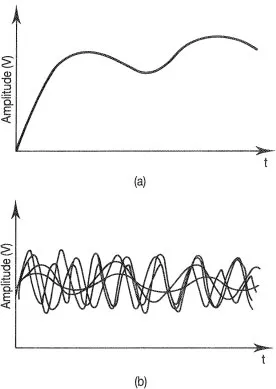
Fig. 1.1 Analogue waveforms
THOUGHT
So digital signals have specified levels and most digital systems respond to binary signals having logic levels ‘0’ and ‘1’? This is true but we must now consider the important aspects of a ‘pulse’ or ‘pulsating’ waveform.

Fig. 1.2 Digital signals
(a) Seven levels
(b) Morse code
(c) Binary code
(a) Seven levels
(b) Morse code
(c) Binary code
Logic gates or digital circuits of any kind respond to or are triggered by pulses, either presented singly as shown in Fig. 1.3(a) or as a ‘pulse train’ in Fig. 1.3(b). You may see from these waveforms that there are two voltage levels involved; a low voltage that represents binary ‘0’ and a higher voltage level representing binary ‘1’.
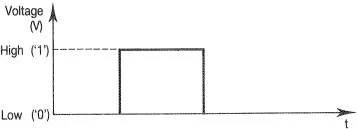
Fig. 1.3(a) Single pulse
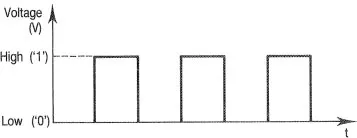
Fig. 1.3(b) Pulse train
Pulse characteristics
Having established the levels for Logic ‘1’ and ‘0’ we must now look at the pulse itself. Fig. 1.4 shows an ideal pulse as it might be displayed on the screen of an oscilloscope. You can see that the pulse appears to change from Low to High instantaneously (in zero time) and that the corners are clean cut and square. The reality is somewhat different, Fig. 1.5 shows the pulse in greater detail. Here it may be seen that there is a finite time taken for the pulse to rise from Low to High, just as it takes time for it to fall from High back to Low, and note that these times may be different. Also the corners are likely to be anything but square and will probably be curved with some ‘ringing’ or ‘overshoot’ present.
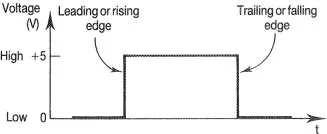
Fig. 1.4 The ideal pulse
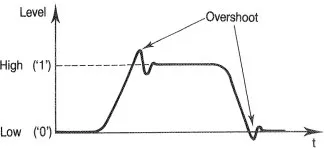
Fig. 1.5 A realistic pulse
Logic devices respond fairly quickly so that the time a pulse takes to change level is important, as is the actual duration of the pulse itself. These characteristics are indicated in Fig. 1.6.

Fig. 1.6 Pulse characteristics
Pulse repetition frequency (prf)
This refers to the number of pulses that occur in one second, e.g. if the prf is 100 Hz then 100 pulses occur in 1 second. This is related to the Periodic Time (T) of the pulse.

Note These definitions are similar to those you have come to know in relation to sine wave signals:

There is a great difference where pulse waveforms are concerned, however, and this can be seen by studying the waveforms of Fig. 1.7. You may notice that in both cases the periodic time (T) and hence the frequency (f) is the same. But in Fig. 1.7(a) the pulse duration is 50 s while the gap or ‘space’ between the pulses is three times as great at 150 μs. In Fig. 1.7(b) however the pulse is three times greater than the space between pulses. In both cases the frequency (f) is the same:

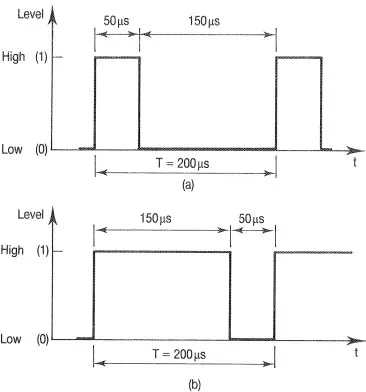
Fig. 1.7 Pulse repetition frequency waveforms
When considering pulse waveforms it is important that the duration of the pulse itself is quoted together with the time between pulses. This may be achieved in two ways.
The Mark to Space Ratio
With reference to Fig. 1.8, the ‘on’ time or pulse duration is termed the ‘mark’ time; and the ‘off’ time or space between pulses is termed the ‘space’ time. The ratio of pulse ‘on’ to pulse ‘off’ time is the mark to space ratio:

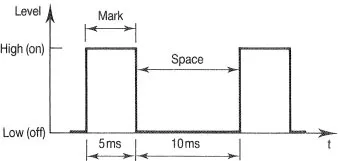
Fig. 1.8 Mark to space r...